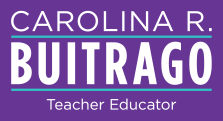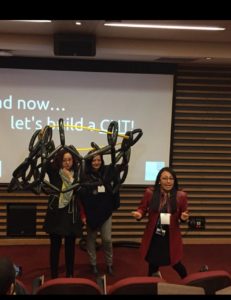Flipping Content and Language Integrated Learning: Easy and Logical
Orgininally posted at https://community.flglobal.org/flipping-content-and-language-integrated-learning-easy-and-logical/ on 19 JAN 2018
Flipped learning is the operating system that makes all other instructional models more viable and effective (Bergmann & St.Clair Smith, 2017)
Since I flipped my first classroom four years ago, I realized that flipped learning (FL) is what allows every other innovation in the classroom to happen. Adopting a flipped mindset, if you will, has facilitated change to happen in my classrooms at an exponential rate. And after flipping in a myriad of settings, I can assure that flipping works. However, as suggested by Bergmann and St.Clair Smith (2017), researchers are no longer lingering on whether Flipped Learning works but on what makes it work better (p. xix). So, it is now our turn, teachers in the field, to show the world the multiplicity of applications of flipped learning in every educational context and every classroom. That’s the reason why I’m writing this post, to inform the Flipped Learning community of yet another use for this amazing “meta-strategy” (Bergmann and St.Clair Smith, 2017).
In 2014, I participated in the 5th biennial conference about Content and Language Integrated Learning (CLIL) at Universidad de La Sabana in Colombia. I had just started flipping, so I was a very avid reader about everything related to FL, and I couldn’t help but to find that it would allow CLIL to happen seamlessly since I watched videos about a teacher who had flipped her Math classroom and I had read Bergmann and Sams book where they shared their story flipping Chemistry, so for me it was just logical that CLIL could be flipped. So, I prepared a workshop called Flipping CLIL: Affordances and Constraints and delivered it at the conference. Participants in the session, including Do Coyle, one of the pioneers of CLIL, enjoyed it quite a lot and suggested me to take it further. Coyle mentioned flipping CLIL was a great idea, and suggested me to write it up. This was in 2014!!! But you know, life happens and we leave projects hanging (I do that a lot!). I have spoken about this idea in the Techno-CLIL EVO sessions for two consecutive years (2016 and 2017) and will do it again this year, but this year, I will finally give it written shape and send it to the world. So, this post will be part of this idea of disseminating this message.
But, first things first…In this community, people know what flipped learning is, sure. But what is CLIL? Please, bear with me as I give you a bit of context. North American readers might not be familiar with the term since it is a European concept. Content and Language Integrated Learning (CLIL) is a “dual-focused educational approach in which an additional language is used for the learning and teaching of both content and language” (Coyle, Hood & Marsh, 2010, p. 1). It was first used in Europe trying to solve the problems generated for foreign students due to their parents’ constant mobility and the need to live and learn in new languages. In the US and Canada, there were also some models in which language was taught through content classes such the Sheltered Instruction Observation Protocol (SIOP) (Echevarria & Vogt, 2002) and Content Based Instruction (CBI). However, I’m talking about CLIL, because even though we don’t have the same mobility issues Europeans have in my country, many Colombian schools have decided to adopt it as a way to strengthen bilingualism processes and many schools and teachers are dealing with it still with some difficulties. McDougald (2015) even mentions in his study results indicate “there are still many teachers who are not aware of the CLIL approach even though many of them are currently teaching content in English and or some form of English as a foreign or second language” (p. 31)
As a teacher trainer, I have witnessed different teachers’ fears and difficulties in regards to CLIL. These difficulties are regularly about three major situations faced by teachers. Firstly, language teachers who sometimes have to either teach content in English (i.e. science or math), or support the content teachers in the process. Secondly, content teachers who might not have a very strong level of English and still have to face the challenge of teaching their class in English. And thirdly, have teachers in general and the training they need to be able to make CLIL work in their classrooms. I have realized how flipping CLIL might be a solution to those three difficulties by means of the conscious planning for the 4 Cs of CLIL (Content, Communication, Cognition and Culture) integrated with the principles of flipped learning. Let me show you how in a very simple way!
Situation 1: Language teachers having to teach/support content teaching
As some language teachers face the challenge to teach content in English even when they are not content experts, flipping their classes can really help them 1) offer a fruitful learning experience to students; 2) learn about the content they are teaching.
To plan their flip, teachers could use sites like Khan Academy, TED Ed, and some YouTube channels to find current, contextualized and rigorously prepared materials for students to approach while in the individual learning space, and then in the group learning space, the teacher could prepare activities for students to develop the communication, cognition and culture Cs for CLIL and also, critical thinking. If language teachers teaching content take out the direct instruction from their classes and replace it with existing, real materials, they can optimize the learning experience for their students. I have adapted Coyle, Hood and Marsh (2010)’s lesson planning scheme. The computer icon represents the part of the lesson that can be flipped by being assigned to students to work in the individual learning space, and the ovals represent what teachers would do in the group learning space.
Situation 2: Content teachers having to teach their subjects in the target language
This situation is very common in Colombia (at least), and it is because even though most teaching degrees offer English courses to their students, they are not very strong and don’t prepare professionals thoroughly to teach their classes in the target language. For these teachers who struggle with English, but are experts in their content, flipping their class will also be beneficial for them and for their students.
Teachers in this situation could flip the communication component of their courses. In the CLIL paradigm, communication observes the language aspects to be learned in order to master the content. There are three different types of language: language of learning (the language needed to understand the topic), language for learning (language needed to operate in a foreign language environment) and language through learning (the emerging language the teacher can not preview). So, let’s say that our Math teacher is teaching the topic of place value. Let’s see what would be the three types of language:
| Language of learning | Language for learning | Language through learning |
| PlaceValue
Units Tens Hundreds Thousands |
How many units are there in a tenth?There are 10 units in a tenth | Students ask about the wordsVenn Diagram and collateral during class. |
As it can be seen in the previous chart, it is easy for the math teacher to preview the math words that students will need to solve problems, understand the place/value chart, etc. because these are words she deals with every day and even if she doesn’t know them in the target language, they are easily translated. Then the language for learning is something she can prepare with the help of the language teacher. These are the words and phrases that students might need to ask for help, to answer questions, etc. And the language through learning will emerge in the class, so the teacher can save those and check later to provide them to students. So, by flipping the language component with the use of teacher created or curated videos can help the content teacher gain confidence and do better. Using my adaptation of Coyle, Hood and Marsh’s diagram, Figure 2 shows what the solution to this situation would look like.
Situation 3: Teacher training in CLIL
Teacher training in CLIL can also benefit from flipping. Teacher training is a pretty solitary and self-directed activity anyway. The best professional development opportunities emerge when teachers look for them, not when the institution they work for imposes some mindless sessions when an “expert” comes to talk about generic topics that are disconnected from the reality of each classroom. So, institutions who know their needs and their teachers can put in place sound flipped teacher training programs. Bergmann and St.Clair Smith, (2017) offer a very comprehensive guide for designing flipped training programs. What the institution would need to do would be to work on the materials that teachers need to learn to CLIL.
In brief, even though this post presents the flipping of CLIL as a very simplistic solution, it might be a good approach for institutions and teachers still struggling with integrating language and content instruction. I’m working hard on this topic and will offer a lesson planning guide for illustrating this integration. Stay tuned!
References
Bergmann, J. and St.Clair Smith, E. (2017) Flipped Learning 3.0: The operating system for the future of talent development. Irving, CA. Flipped Learning Global Publishing
Coyle, D., Hood, P. and Marsh, D. (2010) CLIL Content and Language Integrated Learning. Cambridge, UK. Cambridge University Press.
McDougald, J. (2015) Teachers’ attitudes, perceptions and experiences in CLIL: A look at content and language. Colombian Applied Linguistics Journal. 17(1). P.25-41




